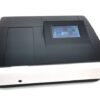Main Features
• Appearance and internal structure
• Modern and elegant appearance, extendable design, separate structure design for optical and circuit system can efficiently avoid the loss of photometric energy.
• Convenient and intuitive operation interface
• This series has 7-inch high resolution color capacitive touch screen and newly developed UV-SUPER2.0 software with strong functions, which make the operation simple and easy.
• Excellent performance and stability
• Totally enclosed monochromator and optical mirror coated with SiO2 guarantee the optical components are not influenced by gas and environment.
• Philips and Milas lamps.
• Newly improved screw pole drive structure makes good wavelength repeatability and high wavelength accuracy.
• Totally new design, superior materials and rigorous production process.
• Advanced photoelectric test system
• 32-bit ARM11 microcontroller with clock speed up to 533MHz
• 20-bit analog digital device specialized for photoelectric data collection and processing from BB company.
• Support internal data storage(32M) and external USB storage.
• Simple and convenient maintenance
• Socket type lamps make the optical adjustment not necessary and maintenance much easier.
• Separated Optical and circuit system has no cross influence and make the instrument more reliable.
• Photometry
There are three test modes: Absorbance, transmittance and energy.
• Quantitative test.
To test sample solution concentration, you can choose different methods like coefficient, standard curve, linearity, linear zero crossing and quadratic. Up to 15 standard samples can be used to build a curve. Advance arithmetic make curvilinear regression more precise and test data more accurate.
• Kinetics Measurement (Time Scanning)
To test the sample chemical reaction process by fixed time scanning the sample solution with fixed wavelength. The equipment can calculate its changing rate after entering the corresponding parameters.
• Wavelength Scanning (Qualitative Test)
To test sample solution absorbance peak, can scan the sample characteristic curve of any wavelength range between 190 and 1100nm. You can look up the peak value on the device standalone.
• Multi wavelength test
It is much more convenient for users to test the absorbance of several wavelengths for the same sample solution, which is much simpler than single wavelength testing.
• DNA/Protein Measurement
It is a special function for specific users to make the operation easier. There are two test modes.






